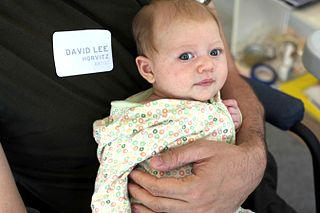
Weaning is the process of gradually introducing an infant human or another mammal to what will be its adult diet while withdrawing the supply of its mother's milk.
Object permanence is the understanding that whether an object can be sensed has no effect on whether it continues to exist. This is a fundamental concept studied in the field of developmental psychology, the subfield of psychology that addresses the development of young children's social and mental capacities. There is not yet scientific consensus on when the understanding of object permanence emerges in human development.
Baby talk is a type of speech associated with an older person speaking to a child or infant. It is also called caretaker speech, infant-directed speech (IDS), child-directed speech (CDS), child-directed language (CDL), caregiver register, parentese, or motherese.

Kangaroo mother care (KMC), which involves skin-to-skin contact (SSC), is an intervention to care for premature or low birth weight (LBW) infants. The technique and intervention is the recommended evidence-based care for LBW infants by the World Health Organization (WHO) since 2003.
James Jerome Gibson was an American psychologist and is considered to be one of the most important contributors to the field of visual perception. Gibson challenged the idea that the nervous system actively constructs conscious visual perception, and instead promoted ecological psychology, in which the mind directly perceives environmental stimuli without additional cognitive construction or processing. A Review of General Psychology survey, published in 2002, ranked him as the 88th most cited psychologist of the 20th century, tied with John Garcia, David Rumelhart, Louis Leon Thurstone, Margaret Floy Washburn, and Robert S. Woodworth.
Cuteness is a type of attractiveness commonly associated with youth and appearance, as well as a scientific concept and analytical model in ethology, first introduced by Austrian ethologist Konrad Lorenz. Lorenz proposed the concept of baby schema (Kindchenschema), a set of facial and body features that make a creature appear "cute" and activate ("release") in others the motivation to care for it. Cuteness may be ascribed to people as well as things that are regarded as attractive or charming.

Figure–ground organization is a type of perceptual grouping that is a vital necessity for recognizing objects through vision. In Gestalt psychology it is known as identifying a figure from the background. For example, black words on a printed paper are seen as the "figure", and the white sheet as the "background".

Gross motor skills are the abilities usually acquired during childhood as part of a child's motor learning. By the time they reach two years of age, almost all children are able to stand up, walk and run, walk up stairs, etc. These skills are built upon, improved and better controlled throughout early childhood, and continue in refinement throughout most of the individual's years of development into adulthood. These gross movements come from large muscle groups and whole body movement. These skills develop in a head-to-toe order. The children will typically learn head control, trunk stability, and then standing up and walking. It is shown that children exposed to outdoor play time activities will develop better gross motor skills.

Infant vision concerns the development of visual ability in human infants from birth through the first years of life. The aspects of human vision which develop following birth include visual acuity, tracking, color perception, depth perception, and object recognition.

Attachment in children is "a biological instinct in which proximity to an attachment figure is sought when the child senses or perceives threat or discomfort. Attachment behaviour anticipates a response by the attachment figure which will remove threat or discomfort". Attachment also describes the function of availability, which is the degree to which the authoritative figure is responsive to the child's needs and shares communication with them. Childhood attachment can define characteristics that will shape the child's sense of self, their forms of emotion-regulation, and how they carry out relationships with others. Attachment is found in all mammals to some degree, especially primates.
Maturation is a guiding notion in educational theory that argues children will develop their cognitive skills innately, with little influence from their environment. Environmentalism, closely related to behaviorism, is the opposite view, that children acquire cognitive skills and behaviors from their surroundings and environment.
Preferential looking is an experimental method in developmental psychology used to gain insight into the young mind/brain. The method as used today was developed by the developmental psychologist Robert L. Fantz in the 1960s.

In visual perception, the kinetic depth effect refers to the phenomenon whereby the three-dimensional structural form of an object can be perceived when the object is moving. In the absence of other visual depth cues, this might be the only perception mechanism available to infer the object's shape. Being able to identify a structure from a motion stimulus through the human visual system was shown by Hans Wallach and O'Connell in the 1950s through their experiments.
Infant cognitive development is the first stage of human cognitive development, in the youngest children. The academic field of infant cognitive development studies of how psychological processes involved in thinking and knowing develop in young children. Information is acquired in a number of ways including through sight, sound, touch, taste, smell and language, all of which require processing by our cognitive system. However, cognition begins through social bonds between children and caregivers, which gradually increase through the essential motive force of Shared intentionality. The notion of Shared intentionality describes unaware processes during social learning at the onset of life when organisms in the simple reflexes substage of the sensorimotor stage of cognitive development do not maintain communication via the sensory system.
The Gibsonian ecological theory of development is a theory of development that was created by American psychologist Eleanor J. Gibson during the 1960s and 1970s. Gibson emphasized the importance of environment and context in learning and, together with husband and fellow psychologist James J. Gibson, argued that perception was crucial as it allowed humans to adapt to their environments. Gibson stated that "children learn to detect information that specifies objects, events, and layouts in the world that they can use for their daily activities". Thus, humans learn out of necessity. Children are information "hunter–gatherers", gathering information in order to survive and navigate in the world.
The fear of falling (FOF), also referred to as basophobia, is a natural fear and is typical of most humans and mammals, in varying degrees of extremity. It differs from acrophobia, although the two fears are closely related. The fear of falling encompasses the anxieties accompanying the sensation and the possibly dangerous effects of falling, as opposed to the heights themselves. Those who have little fear of falling may be said to have a head for heights. Basophobia is sometimes associated with astasia-abasia, the fear of walking/standing erect.
Forty Studies That Changed Psychology: Explorations Into the History of Psychological Research is an academic textbook written by Roger R. Hock that is currently in its eighth edition. The book provides summaries, critiques, and updates on important research that has impacted the field of psychology. The textbook is used in psychology courses at all levels of education and has been translated into six languages. It is used to properly relate the present knowledge of psychology with the original research that led to it. It is a window into the history of psychology for anyone wishing to expand their understanding of the true roots of psychology.
Richard Marx Held was an American professor of Brain and Cognitive Sciences at the Massachusetts Institute of Technology. He conducted some of the first research into visual perception of infants and children. He held a Civil Engineering degree from Columbia University, and earned a PhD in experimental psychology on auditory space perception from Harvard University. In 1973, Held was named to the National Academy of Sciences in recognition of his achievements in psychology. He was also a member of the American Academy of Arts and Sciences.

Karen E. Adolph is a psychologist and professor known for her research in the field of infant motor development. She is the 2017 recipient of the Kurt-Koffka medal from the University of Giessen. Previous honors include the 1999 APA Boyd McCandless Award and 2002 American Psychological Foundation Robert L. Fantz Memorial Award. She has served as the President of the International Congress on Infant Studies. Adolph and her colleagues developed computerized video coding software, called Datavyu, and state-of-the-art recording technology to observe and code behavior. A related project, Databrary, provides a repository for video recordings of behavior and encourages open data sharing across research labs. Adolph is a recipient of a MERIT Award from the National Institutes of Child Health and Human Development in support of her innovative research.

Eleanor Jack Gibson was an American psychologist who focused on reading development and perceptual learning in infants. Gibson began her career at Smith College as an instructor in 1932, publishing her first works on research conducted as an undergraduate student. Gibson was able to circumvent the many obstacles she faced due to the Great Depression and gender discrimination, by finding research opportunities that she could meld with her own interests. Gibson, with her husband James J. Gibson, created the Gibsonian ecological theory of development, which emphasized how important perception was because it allows humans to adapt to their environments. Perhaps her most well-known contribution to psychology was the "visual cliff," which studied depth perception in both human and animal species, leading to a new understanding of perceptual development in infants. Gibson was elected to the National Academy of Sciences in 1971, the National Academy of Education in 1972, and to the American Academy of Arts and Sciences in 1977. In 1992, she was awarded the National Medal of Science.









